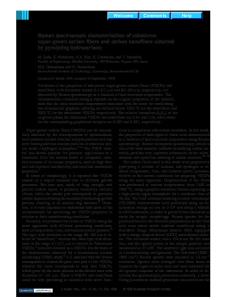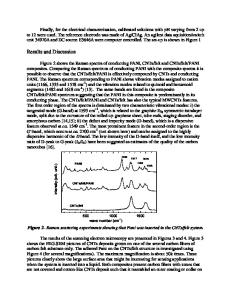Characterization of Microfibers of Carbon Nanotubes Obtained by Electrospinning for Use in Electrochemical Sensor
- PDF / 2,214,483 Bytes
- 15 Pages / 595.276 x 790.866 pts Page_size
- 111 Downloads / 314 Views
ORIGINAL PAPER
Characterization of Microfibers of Carbon Nanotubes Obtained by Electrospinning for Use in Electrochemical Sensor Ana Paula Gusmão1 · Andressa Giombelli Rosenberger1 · Edvani Curti Muniz2,3,4 · Douglas Cardoso Dragunski1 · Josiane Caetano1 Accepted: 4 November 2020 © Springer Science+Business Media, LLC, part of Springer Nature 2020
Abstract Due to the development of new products by the pharmaceutical industry, in which the emerging pollutants waste is generated, it is extremely important to study new methodologies capable of detecting such substances, preferentially in very small concentrations, because they are considered a threat to the environment and health of the population. This paper aims the development of an electrochemical sensor of multi-walled carbon nanotubes (MWCNTs), using electrospun fibers based on Ecovio® (trading name of a blend produced by BASF, Germany). The polymers constituting such blend are poly(butylene adipate-co-terephthalate (PBAT) and poly (lactic acid) (PLA). The parameters used for electrospinning were: 15.0% of Ecovio® (m/v); 0.60% of MWCNTs (m/v); flow of 1.8 mL h−1; distance needle-collector of 16 cm and voltage of 18 kV. The evaluation of the morphology and diameter of fibers were conducted by analysis of images from scanning electron microscopy (SEM). Average fiber diameters of 2.24 ± 0.39 μm for Ecovio® fiber and 2.23 ± 1.19 μm for fiber with MWCNTs were obtained, noticing an increase in the number of beads with addition of MWCNTs. Analysis through transmission electron microscopy (TEM) showed that MWCNTs are mostly inside of the fibers, corroborating with the results of the analysis of the contact angle, which evidenced no change in hydrophilicity of fibers due to presence of MWCNTs and with the analysis of FTIR, which did not demonstrate changes in the bands on respective spectrum. However, mechanical analysis indicates the existence interactions between MWCNTs and polymer, due to the decrease of the resistance and rupture tension of the films with the addition of MWCNTs. Moreover, this interaction can also be noticed in thermogravimetric analysis (TGA), due to the decrease of 13.9 °C and 8.2 °C in the temperatures of the beginning of the degradation in the first and second thermal event and there was also an increase of the crystallinity of the material after the addition of MWCNTs, a result proven by differential scanning calorimetry (DSC) and X-ray diffraction (DRX). The obtained fibers were also submitted to thermal treatment due to the non-conductor character of the polymer. For the material obtained after the firing, a FTIR analysis was performed, in which characteristic bands of the polymer were observed, indicating the presence of the polymer even after thermal treatment. Although, this result did not adversely affect the electrochemical response of the material, as indicated in the results obtained in the electrochemical tests, performed by cyclic voltammetry (CV) containing the drug metronidazole.
* Josiane Caetano [email protected] 1
Un
Data Loading...










